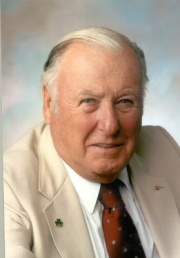James William Cooley
Born September 18, 1926; with John Tukey, creator of the fast Fourier transform.

Education: BA, arts, Manhattan College, 1949; MA, mathematics, Columbia University, 1951; PhD, applied mathematics, Columbia University, 1961.
Professional Experience: programmer, Institute for Advanced Study, Princeton University, 1953-1956; research assistant, mathematics, Courant Institute, New York University, 1956-1962; research staff, IBM Watson Research Center, 1962-1991; professor, electrical engineering, University of Rhode Island, 1991-present.
Honors and Awards: Contribution Award, Audio and Acoustics Society, 1976; Meritorious Service Award, ASSP Society, 1980; Society Award, Acoustics Speech and Signal Processing, 1984; IEEE Centennial Award, 1984; fellow, IEEE
James W. Cooley started his career in applied mathematics and computing when he worked and studied under Professor F.J. Murray at Columbia University. He then became a programmer in the numerical weather prediction group at John von Neumann's computer project at the Institute for Advanced Study in Princeton, New Jersey. [See the biography of Jule Charney.] In 1956, he started working as a research assistant at the Courant Institute at New York University, New York. Here he worked on numerical methods and programming of quantum mechanical calculations (Cooley 1961). This led to his thesis for his PhD degree from Columbia University.
In 1962 he obtained a position as a research staff member at the IBM Watson Research Center in Yorktown Heights, New York. Here he worked on numerical methods for solving ordinary and partial differential equations, solutions of hole-electron diffusion equations for semiconductors, and numerous other research projects. He collaborated with Fred Dodge, a neurophysiologist, in research in neurophysiology including modeling of electrical activity in nerve membranes and in heart muscle (Cooley and Dodge 1966).
With John Tukey, he wrote the fast Fourier transform (FFT) paper (Cooley and Tukey 1965) that has been credited with introducing the algorithm to the digital signal processing and scientific community in general.
Cooley spent the academic year 1973-1974 on a sabbatical at the Royal Institute of Technology, Stockholm, Sweden. He gave courses on the FFT and its applications there and in several other locations in Europe and worked on new versions of the FFT and on number theoretic Fourier transforms.
In 1974 Cooley started collaboration with S. Winograd and R. Agarwal on applications of computational complexity theory to convolution and Fourier transform algorithms (Agarwal and Cooley 1977).
Around 1985 he worked with a group that programmed the elementary functions for the new IBM 3090 Vector Facility. He and the same group also produced the Digital Signal Processing subroutines for the Engineering and Scientific Subroutine Library (ESSL) for the IBM 3090 Vector Facility and, later, for the new IBM RS6000 computer (Agarwal and Cooley 1987).
Cooley retired from IBM in 1991 and joined the faculty of the Electrical Engineering Department of the University of Rhode Island as director of the computer engineering program.
BIBLIOGRAPHY
Significant Publications
Agarwal, R.C., and J.W. Cooley, "New Algorithms for Digital Convolution," IEEE Trans. Acoust., speech, Signal Processing, Vol. ASSP-25, No. 5, Oct. 1977, pp. 392-410.
Agarwal, R.C., and J.W. Cooley, "Vectorized Mixed Radix Fourier Transform Algorithms," IEEE Proc., Sept. 1987, pp. 1283-1292.
Cooley, J.W., "An Improved Eigenvalue Corrector Formula for Solving the Schrodinger Equation for Central Fields," Mathematics of Computation, Vol. 15, No. 7, Oct. 1961, pp. 363-374.
Cooley, J.W., and F.A. Dodge, Jr., "Digital Computer Solutions for Excitation and Propagation of the Nerve Impulse," Biophysical J., Vol. 6, No. 5, 1966.
Cooley, J.W., and J.W. Tukey, "An Algorithm for the Machine Calculation of Complex Fourier Series," Mathematics of Computation, Vol. 19, Apr. 1965, p. 297.
UPDATES
Portrait changed (MRW, 2012)
James Cooley died on June 29, 2016 in Huntington Beach CA. (THVV, 2017)
New content Copyright © 2013-2023 by the IEEE Computer Society and the Institute of Electrical and Electronics Engineers Inc.
All rights reserved. This material may not be reproduced or redistributed without the express written permission of the copyright holder.
